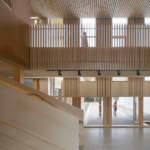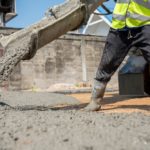News - Construction News
A rounded approach to sustainability

The circular economy as a phrase has become ubiquitous across the construction and manufacturing industry. Although somewhat overused, the concept has radically transformed our industries’ methods and practices over the past decade.
With environmental concerns now a key driver along with capital costs, flexibility will be crucial whether we are building from scratch or renovating existing sites. It’s clear we should be concentrating on building for future retrofit, not future demolition[1].
The circular economic model offers a clear and definitive pathway, particularly for manufacturers of building products, to achieve this goal. At the Concrete Block Association (CBA), sustainability is at the heart of our members’ business strategy as they look to ‘reduce, reuse, recycle and recover’ energy from procurto end-of-life and beyond.
We know that intrinsically, concrete structures are highly durable, a fundamental requirement for whole-life performance. Yet concrete also possesses unique attributes which minimise CO2 emissions. When specified correctly, concrete blocks can significantly minimise embodied CO2. The material’s thermal mass qualities are therefore advantageous, as they can also greatly reduce the operational emissions from heating and cooling a building, without compromising on comfort.
This is just one way in which our members are indirectly making a contribution to the move towards a greener, more eco-friendly built environment. However, there are more proactive, direct ways in which they are looking to promote. Here, I want to take the opportunity to outline some of the activity which is being undertaken to foster best practice within the building products manufacturing industry, and the benefits for the built environment.
Material values
One of our greatest success stories over the past decade has been to significantly reduce CO2 emissions associated with the production of concrete blocks. A remarkable reduction of 13% carbon intensity since 2008 has been made possible through improvements to the manufacturing process. Furthermore, the impact of emissions through transportation, associated with a number of building products, are reduced as the majority of blocks produced in the UK are made in local product plants ensuring local deliveries, thus reducing the carbon footprint.
Of course, cement accounts for the majority of a block’s environmental impact. However, while it remains an important part of the composition, manufacturers are blending other lower impact cementitious materials with it, consequently reducing the overall embodied CO2. These more environmentally friendly substances are industry by-products; ground granulated blast furnace slag (GGBS) and fly ash from the power industry being the two most commonly used.
Mass appeal
While adapting our approaches to a changing climate, we should also build with materials which make for comfortable homes. Using building products which provide inertia against temperature fluctuations will improve energy efficiency and help homeowners by potentially reducing energy bills.
A concrete block’s thermal mass is one of the most important ways in which the whole life CO2 performance of buildings can be enhanced. They absorb and store excess heat during the day, which can be removed passively overnight through ventilation.
It’s essentially an alternative method of temperature control, allowing a structure to naturally retain heat and release it gradually, minimising the need to resort to air conditioning or central heating.
The second coming
It’s important to look beyond the initial end-of-life. A crucial aspect of the circular economy is to find ways to reuse and recycle products, reimagining them beyond their lifespan. For concrete blocks this could be in groundworks, piling mats and landscaping. Equally they can be crushed and used as recycled aggregate. Clarifying our commitment to secondary life, our members have publically pledged that all blocks they manufacture are 100% recyclable.
Deconstruction and waste processing at the end of a building’s life results in more CO2. Therefore we all have a responsibility to improve how building products are manufactured and specified for construction.
As part of our ongoing work, the CBA is actively encouraging producers to introduce measures to reduce energy consumption, eliminate waste and implement environmental and sustainable management systems beyond what is required by government.
Lean and flexible design
Beyond manufacturing, the architectural and wider construction industry need to also be on board for the Circular Economy concept to work. We need to hammer home the message of material efficiency and lean design; using less of our resources and to better effect.
Rapidly improving technology and innovation are enabling us to work smarter and more efficiently. For example we are now able to ascertain the optimal thickness of structures needed for best energy efficiency.
Essentially, flexibility must be built in so the building can assume new uses, incorporating new technologies and changing climactic conditions. There’s a long way to go until the construction and manufacturing industries are truly ‘circular’, but we are taking great steps towards it. Even in these economically uncertain times we need to maintain momentum, and we’ll thank ourselves for this effort further down the line.
Article submitted by Chris Stanley, Housing Manager, Concrete Block Association
If you would like to read more articles like this then please click here.
Related Articles
More News
- Reforms to Building Safety Regulator to accelerate housebuilding
15 Jul 25
Delays to building new high-rise homes will be unblocked through a new package of reforms
- New £39Bn Social and Affordable Homes Programme
14 Jul 25
Hundreds of thousands of social and affordable homes, including 60% for social rent.
- UK Introduces New Trade Measures to Support Steel Sector
11 Jul 25
Steel producers across the UK will benefit from stronger trade measures from 1 July.






